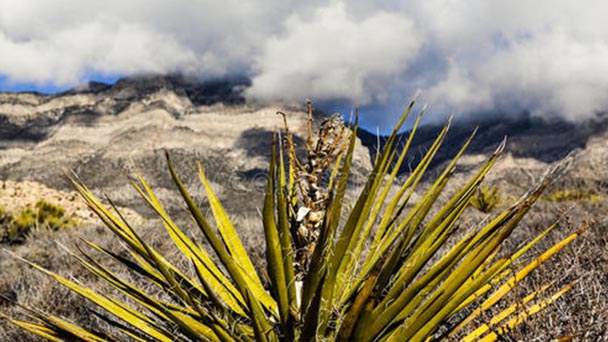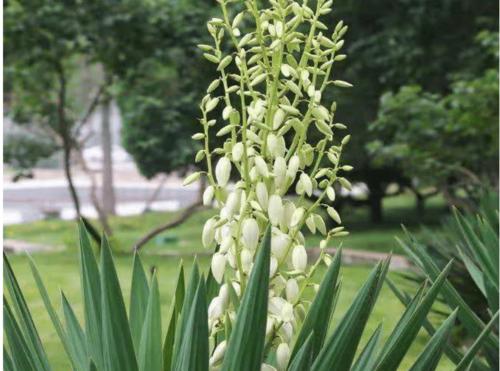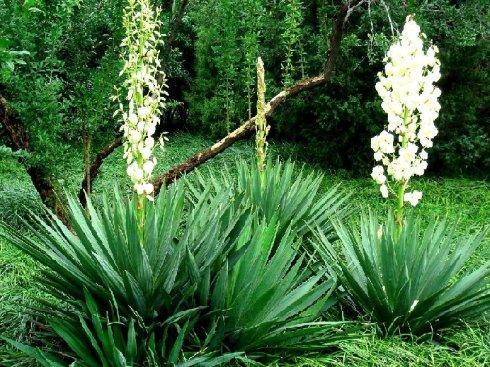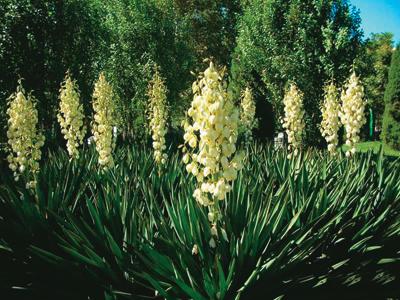Yucca profile
Written by Maggie
Sep 09 2021

In the Seychelles there is a flower that tries to blossom with elegance and then becomes the national flower of the country. It is the Yucca. Yucca has also been introduced to many scenic spots in China.
Yucca picture
Morphological characteristics of Yucca
Yucca is an evergreen shrub, short stems, leaves clustered at base, spirally arranged, leaf blade thick, 50-80 cm long, 4-7 cm wide, apex stiffly spiked, leaves wrinkled, thick green with a small amount of white powder, firm and oblique, margin smooth, old leaves with a few filaments. Flowers bloom in summer and autumn, axes from leaves, erect 1 -- 1.5 m tall, panicles, cup-shaped, pendulous, white, margin greenish-white with reddish, 8 -- 10 cm in diameter. 6 petals are spatulate, 6 flattened free stamens, 3 triangular rod-shaped compound pistils, ovary superior. The capsule is oblong-ovate, sulcus 6, 5-6 cm long, not split.
Yucca growth environment
Yucca is a tropical plant with strong sex and easy survival. It is highly adaptable to soil and can grow well on any soil. It likes the environment with sufficient sunshine and good ventilation, and is very resistant to cold. It is suitable for open field cultivation in North China. Yucca has developed roots and strong vitality. Its leaves have a thicker cuticle and wax coating, which reduces evaporation, so they are particularly resistant to drought.

Yucca propagation methods
Both sexual and asexual propagation can be used. A large number of seeds can be obtained by sexual propagation, but most of the cultivated Yucca plants in China are "flowering false". The reason is a lack of insect pollination. There are two solutions: 1. Artificial assisted pollination, between 8 am and 4 PM on a sunny day, takes the stamens with tweezers and applies the pollen to the stigmata of the pistil. 2. During flowering, cut off two petals from each flower to allow insects to enter the flower freely for pollination. Asexual propagation means that in spring and autumn, the budding tillers from the mother plant are dug, directly planted or transplanted to the ground, and the leaves are stripped and cut into small segments of 10 cm long for cuttage propagation.
Yucca has no special requirements for cultivation and management.
Yucca main use
Yucca is an ornamental plant with beautiful flowers and leaves.
Yucca has strong resistance and absorption ability to harmful gases such as sulfur dioxide, hydrogen fluoride, chlorine gas and ammonia gas. The results showed that many trees, such as Juniper chinensis, heather, Winter primrose, paulownia and so on, showed severe victimized symptoms in an environment with an average daily concentration of 0.15 ml/m3 of SO2, but Yucca was still strong and strong. Yucca also has a strong ability to absorb hydrogen fluoride, according to the determination, 1 kilogram of dry leaves can absorb fluorine 266 mg. In addition, Yucca has certain resistance to ammonia gas and ethylene, so Yucca cultivation should be vigorously promoted in heavily polluted areas.

Latest Updated
- Benefits of Bugleweed - 7 Science-backed Health Benefits
- Bugleweed Dangers & Side Effects - Is It Poisonous?
- How to Plant Evergreen Trees - What You Should Know
- When to Plant Evergreens - Grow Guide for Evergreen Trees
- 12 Wonderful Evergreen Shrubs for Your Garden
- 12 Popular Evergreen Plants with Pictures for Beginners
- When And How To Prune A Lilac Bush Like a Pro
- How to Grow & Care for Lilac Vine (Hardenbergia Violacea)
- Japanese Lilac Tree (Syringa Reticulata) Care & Propagation Guide
- Shumard Oak Pros and Cons - What to Know
Popular Articles
- Winter maintenance of Antirrhinum Majus
- How to Grow Terminalia Mantaly Tree
- How to Grow and Care for Crossostephium Chinense
- How to grow Antirrhinum Majus in spring
- Peristeria Elata (Dove Orchid) Profile: Info & Care Guide
- Underwatered Snake Plant (Sansevieria Trifasciata) - Signs And How To Fix
- How to Care for Brazilian Jasmine Plant (Mandevilla Sanderi)
- How to Grow & Care for Graptopetalum Purple Delight in Summer
- Rosa Chinensis (China Rose): Plant Growing & Care Tips
- How to Care for Baby Sun Rose (Aptenia Cordifolia)
